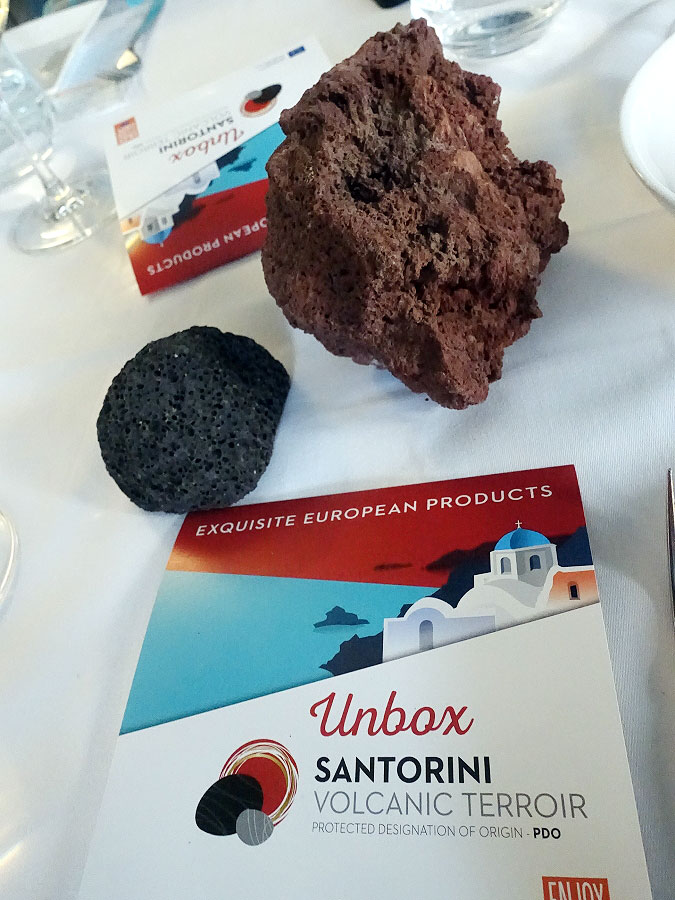Winemaking began in Santorini in 3500 BC, more than 5,000 thousand years ago. In the classic Greek era, the island was called Thera, while today is officially called Thira. The massive volcanic eruption of 1600 BC ultimately created island's caldera and shape as it is today. This explosion left behind a mixture of volcanic ash, pumice stone and pieces of solidified lava and sand, which together make up the soil of Santorini. This soil has little to no organic matter, but is rich in essential minerals, except potassium, thus creating wines with a naturally low pH level and high acidity. All of these factors contribute to creating agricultural products with a distinct profile.
Wines grown on volcanic soils also travel well. As such, when the Italians discovered Santorini in 1200 AD, they began trading wines from the island in amphoras. The wine that was traded the most was the delectably sweet Vinsanto dessert wine and it was exported throughout the Mediterranean and Europe. It was also sent back home to the Pope in Italy - a practice that still occurs today as The Pope receives the oldest and some of the finest Vinsanto directly from Santorini.
Most of the wine production on Santorini consists of white wines and dessert wines. Assyrtiko is the main white grape grown as it thrives in its birthplace, the volcanic island of Santorini. According to appellation rules, Protected Designation of Origin (PDO) Santorini white wines must contain a minimum of 75% Assyrtiko. Most often, it is produced as a single varietal wine, but can also contain the varietals Athiri and Aidani. Nykteri wines are also made with Assyrtiko and aged for at least three months is oak barrels. Vinsanto wines are naturally sweet dessert wines made from sun-dried grapes, must contain at least 51% Assyrtiko and be aged for at least 24 months in oak barrels, allowing the wine to develop additional complexities. PDO Santorini wines have great ageing potential due to their unique characteristics that stem from their volcanic origin, as well as their naturally high acidity and minerality.
All of the wines we tasted during the luncheon were from the Union of Santorini Cooperatives, also known as SantoWines. This co-operative was founded in 1947 and today it is the largest winery on the island, representing more than 1,200 active growers of grapes and other agricultural products. SantoWines is committed to safeguarding local traditional cultivations, producing high quality PDO Santorini wines, tomatoes, and fava, as well as promoting sustainable agriculture development.
In addition to the fine wines from Santorini, there were also a couple of other food items from this small and rich volcanic island. Santorini fava beans are scientifically known as "Lathyrus Clymenum L." and have been grown exclusively on the island for more than 3,500 years. These fava beans are considered a superfood as they have amazing nutritional value and contain more than 20% plant-based protein. Traditionally dried and aged under the sun, this legume has a rich, velvety texture and an earthy, slightly sweet taste.
Santorini tomatoes, commonly known as tomataki, are one-of-a-kind as they are dry-farmed on volcanic soils. They have thick skins with a ruffled shape, a concentrated full-body and a naturally sweet taste. Tomataki also have more vitamin C than regular tomatoes and more lycopene (antioxidant) than any other fruit or vegetable. Tomataki also makes a unique tomato paste, which we got to enjoy during lunch. It has a distinctive dark red colour, velvety texture, and a sweet and slightly minerally taste that was great for dipping with bread.
The wines, as well as the unique Santorini food items can all be purchased through Kolonaki Group. You can also purchase these wines at the LCBO Greece Destination outlet at 200 Danforth Avenue (Toronto), while the first Assyrtiko in the list below is widely available across Ontario.
Thank you Kolonaki Group for the invitation and the opportunity to try these delicious Santorini foods and wines. Lunch was delicious and I was pleasantly surprised to find that my lamb dish paired beautifully with these white wines. Wine reviews of these delicious wines are provided below and I trust that you will enjoy them as much as I dd. Opa!
Tasting Notes:
SANTO SANTORINI ASSYRTIKO 2017 - PDO Santorini, Greece (#459032) (XD) - $23.30Medium+ intensity nose is clean with citrus, herbs and minerality with hints of saline. It is medium+ bodied and concentrated on the minerally-textured palate with nicely balanced aromas replays on the flavour profile. It is structured with vibrant acids, and has a long, juicy finish. Score: 89 pts
SANTO NYKTERI 2017 - PDO Santorini, Greece (XD) - $33.95
A blend of 75% Assrytiko, 15% Athiri, and 10% Aidani that was harvested at night to keep freshness. Spent 3 months in oak barrels. This is ripe with roasted pineapple, stone fruit, ripe apple, pear, citrus, and melon, with subtle oak influence. All of which comes through on the vibrant palate with lively acids. Clean, elegant and nicely balanced with excellent finish length. Score: 90 pts
SANTO GRANDE RESERVE ASSYRTIKO 2016 - PDO Santorini, Greece (#814186) (XD) - $57.95
This Assyrtiko spent 1 year in French oak barrels. The medium-high intensity nose has a subtle oak influence with Meyer lemon citrus, baked apple, butter, and stone fruit aromas and flavours. It is medium-full bodied and structured with vanilla notes appearing on the palate. There is a nice mineral texture to go along with juicy acids. Long on the finish. Score: 91 pts
SANTO VINSANTO 2011 - PDO Santorini, Greece (#654722) (S) (500 mL) - $67.95
Sun-dried 85% Assyrtiko and 15% Aidani grapes that spent 3 years in oak barrels. Deep orange-red-brown colour. Offers complex aromas of sweet spice, golden raisin, fig, dates, plum, honeyed, brown sugar and hints of hazelnut. Full-bodied with more raisin, fig, and sweet plum notes on the palate, with very good acidity and flavours lingering on the long finish. Score: 89 pts
















0 comments:
Post a Comment
Note: Only a member of this blog may post a comment.